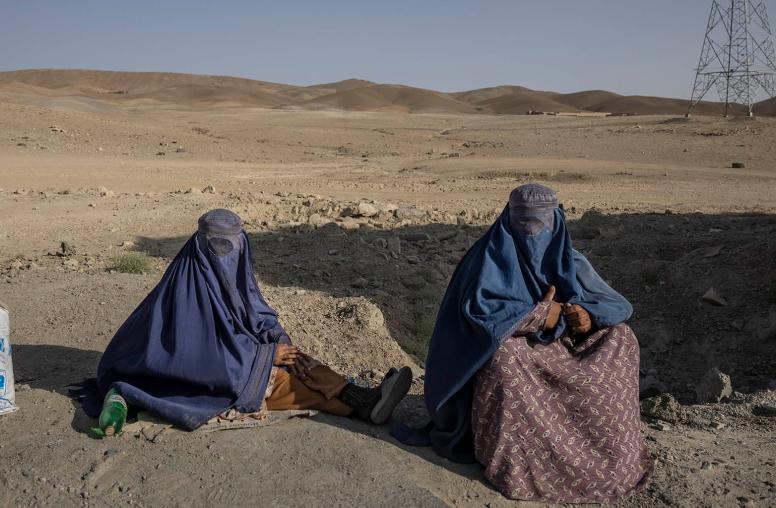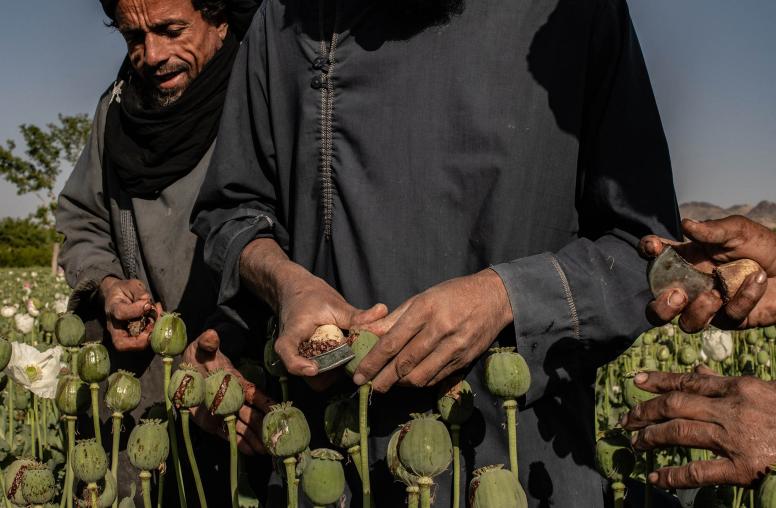An Essential for Afghan Peace: Funding the Government
2019 data highlight key steps to boost state revenues—and sustain donors’ aid.
A critical ingredient for the current efforts to bring stability and peace in Afghanistan is the Afghan state’s ability to pay for more of its own operations. Despite optimistic new reports from the Afghan government, its actual revenues stagnated last year. With international donors still funding around half of Afghan government expenses, urgent improvements are needed in the way the government collects and measures its revenues. These changes are vital to persuade donors to sustain funding when their current assistance pledges expire in just 10 months—and to help strengthen the government in prospective negotiations with the Taliban.

Afghanistan has increased its revenue greatly since 2002, funding a rising share of civilian expenditures, although the war and insecurity have expanded security sector spending beyond a sustainable level. Afghanistan must continue that revenue growth to show donors it can progressively reduce its dependence on aid. New official data suggest impressive progress in 2019—an 11.9 percent increase in government revenue. That figure, if realistic, would be the more surprising since the Afghan economy was so weak.
But the reality for 2019 is that the government’s tax revenues, which come from customs duties and domestic taxes, stagnated. Tax revenue increased nominally by less than 1 percent and customs duties by just 2 percent. Indeed, the latter declined in U.S. dollar value if the depreciation of Afghanistan’s currency, the afghani, is taken into account. The impressive official statistic for revenue growth was derived almost entirely by counting as non-tax revenue $430 million worth of one-time transfers to the state treasury from state-owned organizations. Rather than genuine boosts to the government’s ability to finance its operations, most of these were the central bank’s paper profits generated by the depreciation of the afghani.
5 Steps to Better Fund Afghanistan’s Government
A particular problem in building Afghanistan’s ability to pay for its own government is to end the recent “churn” of senior officials in the Finance Ministry. For about 18 months, the ministry’s operations have been hindered by repeated reshuffling of its management, detailed below. Ending that disruption is one of five steps that would go a long way to improving the performance and the credibility of the government’s revenue gathering, and thus help to sustain donors’ support for the Afghan state:
- The Afghan government needs to appoint and keep a team of competent, non-corrupt officials to lead the Finance Ministry, ending the frequent turnover of senior staff.
- Increased investment is needed to strengthen revenue and customs operations, in Kabul, in provincial offices and at border customs stations. This should serve a longer-term strategy of increased operational autonomy to improve efficiency and reduce loss of revenue due to inefficiency, theft, and corruption.
- One-off transfers as a means of achieving revenue targets should be avoided—and not only to inject transparency. The practice has been shown to depress regular collections from the main revenue streams.
- Central bank transfers should be presented separately in the budget statistics from tax and other non-tax revenues.
- Afghanistan needs to stop the practice of setting unrealistically ambitious targets for government revenues. These should be replaced by achievable targets, backed by sound analysis of underlying factors.
Afghanistan’s effort to collect more revenue has been complicated in the past year by the sustained turmoil around the country’s presidential election. Even after President Ashraf Ghani was recently named the winner of the vote held in September, a political dispute over the result is set to continue. However, the country is in a stronger financial position than four years ago, when a similar dispute over the previous election left the country at the brink of fiscal collapse.
Afghanistan’s stronger position now is due to robust revenue growth, at or near double-digit rates, during 2015-2018. The government was able to build up reserves in its central bank (Da Afghanistan Bank), providing a cushion against poor revenue performance. In 2014, the government ran out of cash to pay its bills and had to ask international donors for $537 million in emergency assistance. As of November 5, 2019, the Finance Ministry’s unrestricted cash balance with the central bank was close to the equivalent of $250 million, sufficient to support regular cash flow. The risk of an outright fiscal crisis along the lines of what occurred in 2014 therefore seems remote.
What Went Wrong—and How it Hurts
The most striking story around Afghanistan’s revenue problems is the extraordinary rate of turnover in senior Finance Ministry staff. Following the replacement of the finance minister in July 2018, wholesale changes were made in the ministry’s management team, including three of its four deputy ministers. In the past year and a half the ministry has had three deputy ministers of revenue and customs, three deputy ministers of administration (a position that is currently vacant), and three deputy finance ministers. The ministry seems to have had three chiefs of staff in the same period. At the next level in the organization, the directors-general have been changed for treasury, budget, public-private partnerships, administration, internal audit (twice), customs, revenue, state-owned enterprises, policy implementation (a post currently vacant), and policy coordination. Lower still, many changes have been made at the director level, with for example the post of human resources director now vacant after apparently having had three incumbents in the past 18 months.
With staff uncertain how long they will be in place, these personnel changes have been disruptive and have no rationale from the perspective of continuity in policies and sound management. Among other problems they undoubtedly make the task of increasing revenue all the more difficult.
The stagnation in 2019 of Afghanistan’s ability to finance its government is no surprise in view of the underlying stagnant economy. The idea that revenue could somehow grow much faster than the economy as a whole, in the absence of major reforms or tax measures, is prima facie unrealistic. And with imports in 2019 down by an estimated 7 percent, it is not surprising that customs duties were flat in local currency terms and declined in U.S. dollar value.
The weakness of the economy and government revenue has been compounded by the political instability engendered by the long and disputed presidential election, the U.S.-Taliban peace discussions and uncertainties over the prospect of some kind of intra-Afghan peace process. Insecurity and violence remain as bad as ever. Private investment and business activity therefore remain depressed, resulting in weak revenue generation.
Within the state bureaucracy, uncertainties such as the disputed election also encourage rampant “short-termism”—the inclination of officeholders to make choices that provide them immediate benefits rather than longer-term prospects. This mindset is a well-known enabling factor for corruption and could have led to diversion of government revenues. Whereas customs has been perennially plagued by corruption and associated revenue losses, domestic tax revenues tended to be more buoyant in the past, and their stagnation in 2019 may in part reflect a worsening in this regard.
Checking the Numbers—and Donors’ Concerns
In the top-line 2019 statistics published by the Afghan government, revenue stagnation is veiled by adding one-time transfers to the treasury. Most of those represent paper profits based on the currency’s drop in value and the rest are unsustainable one-time levies from public entities. The numbers show an extraordinary 31 percent growth in non-tax revenues, to a total 88.5 billion afghanis ($1.1 billion). Fully three-eighths of that (33.4 billion afghanis or $430 million) consisted of those one-time transfers.
After subtracting these one-offs, total revenue in 2019 shrinks to 175.1 billion afghanis (less than $2.3 billion). That is equivalent to 11.8 percent of GDP, meaning that government revenue as a percentage of the overall economy was actually below its level in a number of previous years. Moreover, after one-offs are subtracted from total revenue in both 2019 and 2018 (when they were only 7.9 billion afghanis, or $110 million), revenue growth in 2019 disappears. In fact, it turns slightly negative—a decline of 1.8 percent. Factoring in the impact of currency depreciation on customs duties would show total revenues in a deeper decline—2.8 percent.
The stagnation of tax revenues and heavy reliance on extraordinary one-time transfers to shore up total revenue are problematic as the government moves forward with its 2020 national budget. It will be even more difficult to grow revenue this year than in 2019, given the higher base due to overstated revenue in 2019.
Moreover, the government will be trying to persuade donors to renew their development aid pledges, which date from 2016 and will expire at the end of this year. Robust revenue growth provides a strong signal to donors of the government’s commitment to increase revenue and over time ease its dependence on external support. The hollowness of revenue performance in 2019 therefore may concern donors as they consider how much aid to provide Afghanistan in coming years, and how much of their aid to continue to channel through the Afghan budget.
Stagnant revenue could also weaken the government’s position in talks with the Taliban. Not having a strong public finance foundation might well undercut the government’s credibility, as well as reducing its capability to govern and manage its activities during what is sure to be a long, hard peace process.



